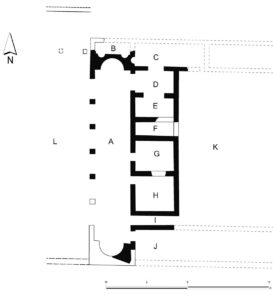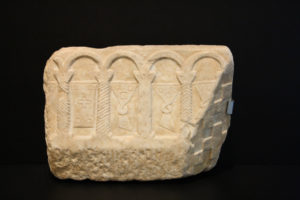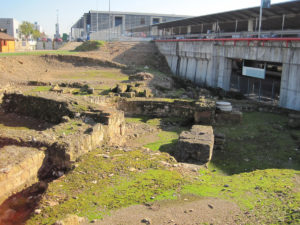
Christian Architecture

After the legalization of the religio christiana in 313 (Edict of Milan), the Church acquired full right to erect worship buildings designed for that purpose.
Since Cordova was a bishopric since at least the end of the third century, the city had an Episcopal Complex with at least a cathedral church, a baptistery and an Episcopal palace. In the current state of the research, the majority of the scientific community considers that the main church (dedicated to St. Vincent) was located at the southern end of the city from the late fourth-early-fifth century or even earlier. The scarce archaeological information about the Episcopal Complex in the fourth and fifth centuries, contrasts with the documentation relating to the sixth and seventh centuries, when it could occupy about two hectares of extension. Excavations carried out under the present-day Mosque-Cathedral, and immediately south of that point, have brought to light several monumental buildings from the sixth-seventh centuries whose exact functionality has not always been determined.

Although in the remaining intramural area of the city there must have been other churches, at the moment we do not have any construction that can be certainly interpreted as a church.
As far as the extramural space is concerned, thanks to some antique and medieval sources we know the existence of three basilicas (dedicated to San Acisclo, San Zoilo and the Three Crowns) whose exact location has not been accurately determined. So far, the only suburban religious complex well-known is Cercadilla, where some material testimonies reflect its sacred use in the sixth and seventh centuries. More controversial are other structures discovered in points such as the area of “Cortijo de Chinales” (Garden City neighborhood), or the former amphitheater, since its religious functionality has not been fully confirmed.


Bibliography
ALORS, R.M. et alii (2015): “La Córdoba del siglo de Osio: una ciudad en transición”, en A. J. REYES (ed.), El siglo de Osio de Córdoba, Madrid, 55-99.
ARJONA, A. (2008): “Las basílicas mozárabes”, Al-Mulk, nº 8, 34-52.
BERMÚDEZ, J.M. (2010): “El atrium del complejo episcopal cordubensis. Una propuesta sobre la funcionalidad de las estructuras tardoantiguas del patio de la Mezquita de Córdoba”, Romula, nº 9, 315-341.
BERMÚDEZ, J.M. (2011): “Mobiliario litúrgico del complejo cultual cristiano de Cercadilla, Córdoba: (Columnitas, estípites y mensa)”, Romula, nº 10, 277-306.
BERMÚDEZ, J.M.; LEÓN, E. (2008): “Piezas decorativas visigodas del Alcázar Cordobés”, Anejos de Anales de Arqueología Cordobesa, nº 1, Córdoba, 85-106.
CASTRO, E.; PIZARRO, G.; SÁNCHEZ, I. (2006): “El conjunto arqueológico del Parque Infantil de Tráfico de Córdoba. La ocupación tardoantigua del suburbium occidental de Colonia Patricia–Corduba”, Anales de Arqueología Cordobesa, nº 17, vol. II, 103-118.
GONZÁLEZ, M.L.; MORENO, M. (1997): “Un conjunto de placas cerámicas tardoantiguas decoradas a molde procedentes de Córdoba”, Almirez, nº 6, 123-135.
HIDALGO, R. (2002): “De edificio imperial a complejo de culto. La ocupación cristiana del palacio de Cercadilla”, en D. VAQUERIZO (ed.), Espacios y usos funerarios en el Occidente Romano, vol. II, Córdoba, 343-372.
HIDALGO, R.; VENTURA, A. (2001): “Posible baptisterio en el Palacio de la Merced”, en D. VAQUERIZO (coord.), Funus Cordubensium. Costumbres funerarias en la Córdoba romana, Córdoba, 251-252.
JURADO, S. (2008): “El centro de poder de Córdoba durante la Antigüedad Tardía: origen y evolución”, Anales de Arqueología Cordobesa, nº 19, 203-230.
MARFIL, P. F. (1996): “El templo paleocristiano descubierto en la antigua iglesia del convento de Santa Clara, de Córdoba”, Boletín de la Real Academia de Córdoba, nº 67, Córdoba, 197-210.
MARFIL, P. F. (2000): “La sede episcopal cordobesa en época bizantina: evidencia arqueológica”, en J.Mª.GURT y N. TENA (eds.), V Reunió d´Arqueologia Cristiana Hispànica, Barcelona, 157-176.
MARFIL, P. F. (2007): “La basílica de San Vicente en la Catedral de Córdoba”, Arte, Arqueología e Historia, nº 14, 185-196.
MURILLO, J.F. et alii (2010): “La transición de la civitas clásica cristianizada a la madina islámica a través de las transformaciones operadas en las áreas suburbiales”, en D. VAQUERIZO y J.F. MURILLO (eds.), El anfiteatro romano de Córdoba y su entorno urbano. Análisis arqueológico (ss. I-XIII d.C.). Monografías de Arqueología Cordobesa, nº 19, vol. II, Córdoba, 503-547.
PENCO, F. (2002): “Apuntes sobre un excepcional mosaico de influencia bizantina en el antiguo convento de Santa Clara de Córdoba”, Meridies, nº 5-6, Córdoba, 7-28.
SÁNCHEZ RAMOS, I. Mª. (2007): “Decoración arquitectónica y escultura litúrgica en Corduba”, Hortus Artium Medievalium, nº 13, vol. 2, 423-440.
SÁNCHEZ RAMOS, I. Mª. (2009): “Sobre el grupo episcopal de Corduba”, Pyrenae 40.1, 121-147.
SÁNCHEZ RAMOS, I. Mª. (2010a): Corduba durante la Antigüedad tardía. Las necrópolis urbanas. Bar International Series 2126, Oxford.
SÁNCHEZ VELASCO, J. (2006): Elementos arquitectónicos de época visigoda en el Museo Arqueológico de Córdoba. Monografías del Museo Arqueológico de Córdoba 1, Sevilla.
VAQUERIZO, D.; MURILLO, J. F. (2010): “Ciudad y suburbia en Corduba. Una visión diacrónica (siglos II a.C.-VII d.C.)”, en D. VAQUERIZO (ed.), Las áreas suburbanas en la ciudad histórica. Topografía, usos y función. Monografías de Arqueología Cordobesa, nº 18, Córdoba, 455-522.

